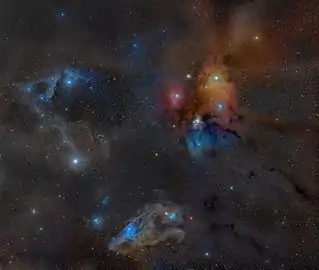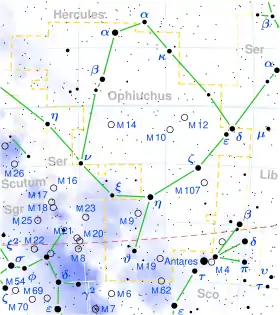Rho Ophiuchi
Rho Ophiuchi (ρ Ophiuchi) is a multiple star system in the constellation Ophiuchus. The central system has an apparent magnitude of 4.63.[2] Based on the central system's parallax of 9.03 mas,[1] it is located about 360 light-years (110 parsecs) away.[1] The other stars in the system are slightly farther away.[8]
| Observation data Epoch J2000.0 Equinox J2000.0 | |
|---|---|
| Constellation | Ophiuchus |
| Right ascension | 16h 25m 35.11766s[1] |
| Declination | −23° 26′ 49.8150″[1] |
| Apparent magnitude (V) | 4.63[2] |
| Characteristics | |
| ρ Oph AB | |
| Spectral type | B2/3V + B2V[3] |
| U−B color index | -0.56[4] |
| B−V color index | +0.24[4] |
| Astrometry | |
| ρ Oph AB | |
| Radial velocity (Rv) | -11.40 ± 3[5] km/s |
| Proper motion (μ) | RA: -5.53[1] mas/yr Dec.: -21.74[1] mas/yr |
| Parallax (π) | 9.03 ± 0.90[1] mas |
| Distance | 360 ± 40 ly (110 ± 10 pc) |
| Absolute magnitude (MV) | -2.5 ± 0.3[6] |
| Orbit[7] | |
| Primary | ρ Oph A |
| Companion | ρ Oph B |
| Period (P) | 2398 ± 326 yr |
| Semi-major axis (a) | 4.25 ± 0.79″ |
| Eccentricity (e) | 0.675 ± 0.322 |
| Inclination (i) | 135.3 ± 6.0° |
| Longitude of the node (Ω) | 77.5 ± 13.5° |
| Periastron epoch (T) | B 2327 ± 343 |
| Argument of periastron (ω) (secondary) | 226.1 ± 15.3° |
| Orbit[7] | |
| Primary | ρ Oph D |
| Companion | ρ Oph E |
| Period (P) | 675.5 ± 32.5 yr |
| Semi-major axis (a) | 1.01 ± 0.15″ |
| Eccentricity (e) | 0.707 ± 0.112 |
| Inclination (i) | 134.8 ± 2.7° |
| Longitude of the node (Ω) | 152.7 ± 4.6° |
| Periastron epoch (T) | B 2008.6 ± 34.2 |
| Argument of periastron (ω) (secondary) | 260.4 ± 1.1° |
| Other designations | |
| ρ Oph A: CD−23° 12861A, HD 147933, HIP 80473A, HR 6112, SAO 184382 | |
| ρ Oph B: CD−23° 12861B, HD 147934, HIP 80473, HR 6113, SAO 184381 | |
| ρ Oph C: CD−23° 12862, HIP 80474, SAO 184383 | |
| ρ Oph D: CD−23° 12860, HD 147888, HIP 80461, SAO 184377 | |
| Database references | |
| SIMBAD | ρ Oph |
| ρ Oph A | |
| ρ Oph B | |
| ρ Oph C | |
| ρ Oph D | |

System
The central pair is known as Rho Ophiuchi AB. It consists of at least two blue-colored subgiants or main-sequence stars, designated Rho Ophiuchi A and B, respectively.[8] Rho Ophiuchi AB is a visual binary, and the sky-projected distance between the two stars appears to be 3.1″, corresponding to a separation of at least 344 astronomical units (au).[8] However, the actual separation is larger, and the two take about 2,400 years to complete an orbit.[7]
Several other stars are located close to Rho Ophiuchi AB. HD 147932 is located 2.5 arcminutes away (at least 17,000 au), and is known as Rho Ophiuchi C.[8] HD 147888 is located 2.82 arcminutes away (at least 19,000 au), and is known as Rho Ophiuchi DE.[8] Stars C and D are both B-type main-sequence stars,[8] and D itself is another binary with an orbital period of around 680 years.[7]
Cloud complex
Rho Ophiuchi is the namesake of the Rho Ophiuchi cloud complex. It is a nebula of gas and dust, which the Rho Ophiuchi system is embedded in. It is one of the easiest star forming regions to observe, as it is one of the nearest, and it is visible from both hemispheres.[9]
The interstellar extinction (AV) of Rho Ophiuchi is measured to be 1.45 magnitudes, meaning the dust and gas in front of Rho Ophiuchi absorbs light from the system, making it appear 1.45 magnitudes dimmer than it should be.[10] Additionally, gas and dust also scatters more higher-frequency light, leaving the light appearing more reddish. The interstellar reddening (EB−V) of Rho Ophiuchi has been measured to be 0.47 magnitudes.[6]
References
- van Leeuwen, F.; et al. (2007). "Validation of the new Hipparcos reduction". Astronomy and Astrophysics. 474 (2): 653–664. arXiv:0708.1752. Bibcode:2007A&A...474..653V. doi:10.1051/0004-6361:20078357.
- Ducati, J. R. (2002). "VizieR Online Data Catalog: Catalogue of Stellar Photometry in Johnson's 11-color system". 2237. Bibcode:2002yCat.2237....0D. Cite journal requires
|journal=(help) - Houk, N.; Smith-Moore, M. (1988). "Michigan Catalogue of Two-dimensional Spectral Types for the HD Stars. Volume 4, Declinations −26°.0 to −12°.0". Michigan Catalogue of Two-dimensional Spectral Types for the HD Stars. Volume 4. Bibcode:1988mcts.book.....H.
- Nicolet, B. (1964). "Catalogue of homogeneous data in the UBV photoelectric photometric system". Astronomy and Astrophysics Supplement Series. 34: 1–49. Bibcode:1978A&AS...34....1N.
- Gontcharov, G. A. (2006). "Pulkovo Compilation of Radial Velocities for 35 495 Hipparcos stars in a common system". Astronomy Letters. 32 (11): 759–771. arXiv:1606.08053. Bibcode:2006AstL...32..759G. doi:10.1134/S1063773706110065.
- Wegner, W. (2003). "The total-to-selective extinction ratio determined from near IR photometry of OB stars". Astronomische Nachrichten. 324 (3): 219. Bibcode:2003AN....324..219W. doi:10.1002/asna.200310081.
- Novaković, B. (2007). "Orbits of Five Visual Binary Stars". Baltic Astronomy. 16: 435–442. arXiv:0712.4242. Bibcode:2007BaltA..16..435N.
- Cordiner, M. A.; Fossey, S. J.; Smith, A. M.; Sarre, P. J. (2013). "Cordiner, M. A., Fossey, S. J., Smith, A. M. and Sarre, P. J. 2013, ApJ, 764, L10" (PDF). The Astrophysical Journal Letters. 764: L10. arXiv:1301.6167. Bibcode:2013ApJ...764L..10C. doi:10.1088/2041-8205/764/1/L10.
- Wilking, B. A.; Gagné, M.; Allen, L. E. (2008). "Star Formation in the ρ Ophiuchi Molecular Cloud". Handbook of Star Forming Regions. arXiv:0811.0005. Bibcode:2008hsf2.book..351W.
- Shatsky, N.; Tokovinin, A. (2002). "The mass ratio distribution of B-type visual binaries in the Sco OB2 association". Astronomy and Astrophysics. 382: 92–103. arXiv:astro-ph/0109456. Bibcode:2002A&A...382...92S. doi:10.1051/0004-6361:20011542.
